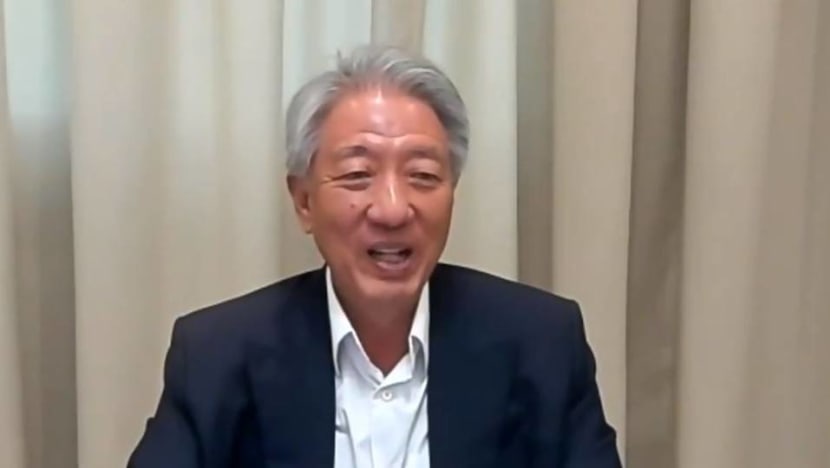COVID-19 pandemic has underscored how ‘closely intertwined’ countries and people have become: Teo Chee Hean

Senior Minister Teo Chee Hean speaking at the Middle East Institute's annual conference on Feb 23, 2021. (Screengrab: Facebook/Middle East Institute)
SINGAPORE: The COVID-19 pandemic has underscored how “closely intertwined” countries and people have become, Senior Minister Teo Chee Hean said on Tuesday (Feb 23).
In an address at the Middle East Institute’s (MEI) annual conference, Mr Teo said it has become even more imperative that countries “rethink, refresh and revitalise our traditional relationships” and build more diverse and wider networks.
Countries should also explore new areas for cooperation in technology, the digital economy and people-to-people ties, added Mr Teo, who is also Coordinating Minister for National Security.
“Asia, including both the Indo-Pacific and the Middle East, is responding to a changing world. The centre of gravity of the world is shifting from the Atlantic to the Pacific and Indian Oceans, in particular in the economic arena,” said the Senior Minister.
“This includes energy and trade flows, and increasingly in two-way trade and investment, capital flows and technology. Many economies in this vast region have been growing much faster than their counterparts in North America and Western Europe, pulling the centre of global economic activity steadily eastwards.”
Both regions are responding to new domestic imperatives, and are undergoing “significant demographic changes”, he said.
Beyond facing similar external and internal circumstances, both the Indo-Pacific region and the Middle East have “unique characteristics” that make engagement and exchanges interesting and fruitful, he added.
The Senior Minister highlighted three key areas: Economic partnerships, religious exchanges and people-to-people interactions.
“Trade between our regions is growing and becoming more diverse,” said Mr Teo.
Singapore was the first country from outside the region to sign a free trade agreement with the Gulf Cooperation Council (GCC), he noted.
The GCC-Singapore FTA, which came into force in 2013, has helped to bolster economic ties over the years and laid the foundations to diversify Singapore’s trade with the GCC, he added.
“When traditional supply chains were disrupted by COVID-19 last year, Singapore looked to the Middle East to diversify our supply chains and safeguard our food supply, such as by importing prawns from Saudi Arabia – something not so traditional, but a useful source for us nevertheless,” Mr Teo explained.
New partnerships are forming in sectors such as technology, sustainability and info-communications development.
“Both sides can work with each other to accelerate their modernisation and diversification efforts,” said Mr Teo.
Through globalisation, societies around the world have become increasingly multicultural and diverse, he noted.
The Middle East has “inspired and influenced the religious beliefs, values and practices of many faiths”, said Mr Teo.
“The major world religions of Islam, Christianity and Judaism trace their origins there. In particular, the Middle East holds special significance as the origin of Islam and the seat of its holiest sites,” he said.
“Muslims in the Middle East and North Africa constitute only 20 per cent of the world’s Muslim population. Here in the Indo-Pacific, we collectively have the largest number of Muslims anywhere in the world, at 62 per cent,” he added.
“The top four countries with the largest Muslim populations in the world, as of 2015, are all in the Indo-Pacific – Indonesia with 12.6 per cent, India with 11.1 per cent, Pakistan with 10.5 per cent and Bangladesh with 8.2 per cent.
“As the seat of Islam, how the Middle East understands the religion, and Islam’s relationships with other faiths, will shape the practice of Islam all over the world, including in Asia.”
He said that many aspiring Islamic religious teachers from the Indo-Pacific region, including Singapore, study in the Middle East and North Africa.
In Singapore, secondary school students have been able to learn Arabic as a third language since 2008.
“The learning of Arabic will bolster our people-to-people ties and promote a better understanding of the Arab world and Islam,” said Mr Teo.
“In fact, this has taken on greater importance today. Islam has unfortunately been misinterpreted and misused in some quarters.
“The Indo-Pacific can work together with the Middle East to stand firm against violence and terrorism, and promote more tolerance, moderation and accommodation among all religions. We should also work together to promote a better understanding of Islam, in particular its fundamental beliefs and values, around the world.”
While the Indo-Pacific and Middle East have their own cultural characteristics, there are also many similarities, noted Mr Teo.
“This has provided the impetus for regular engagement. For example, Korea and Japan are not only major investors in the Middle East over the past few decades; they have also had significant historical cultural and commercial exchanges,” he added.
China established relations with the Middle East in the 7th century, during the Tang Dynasty, and is now re-engaging the region through different ways, including the Silk Road Economic Belt of its Belt and Road Initiative.
“India, given its proximity, shares deep civilizational roots, cultural exchanges and historical linkages with the Middle East,” said the Senior Minister.
“Southeast Asia too has a long relationship with the Middle East.”
The discovery of a shipwreck – a dhow laden with Chinese porcelain decorated with Islamic motifs - off the coast of Belitung Island, Indonesia in 1998 shows the people-to-people exchanges that connected civilisations along the Maritime Silk Road more than 1,200 years ago.
It confirmed that overland routes were not the only trade connections between the East and the West, and that Southeast Asia lay at the heart of a global maritime trading network.
“Muslim traders brought Islam from the heartlands of the Arab peninsula to Southeast Asia. Some Arab traders sank their roots in Southeast Asia, of which the Hadramis from Yemen were the most prominent,” said Mr Teo.
“The Aljunieds, the Alkaffs and the Alsagoffs are among the well known Arab families in Singapore.”
He said that the regions shared a “more recent history”.
“Many of the countries in the Gulf became independent from European powers at about the same time as those in the Indo-Pacific, from the late 1940s to the 1960s. This shared historical context and political experience bind us together,” he added.














